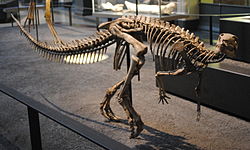Vertebrate paleontology
Newly named dinosaurs
Data courtesy of George Olshevsky's dinosaur genera list. [3]
| Name | Status | Authors | Age | Unit | Location | Notes | Images | |
|---|---|---|---|---|---|---|---|---|
Valid taxon. |
| late Kimmeridgian-Tithonian | A dryosaurid. |  | ||||
| Panoplosaurus [5] | Valid taxon | middle-late Campanian |  | |||||
| Uintasaurus [6] |
| late Kimmeridgian-Tithonian | Junior synonym of Camarasaurus . | |||||
Newly named pterosaurs
| Name | Status | Authors | Age | Unit | Location | Notes | |
|---|---|---|---|---|---|---|---|
Valid | von Arthaber | A rhamphorhynchid; new genus for "Scaphognathus" purdoni Newton (1888). | |||||